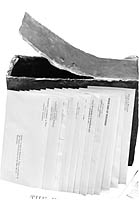Honoring the Past
Pioneers in the Law - The First 150 Women
"I was told that if I wanted a job at a law firm, I'd better
learn typing and shorthand ... we've come a long way, ladies." -
Catherine B. Cleary, 1943 graduate of U.W. Law School

 ontributing to the state's 150th birthday celebration, President Susan
Steingass's "Pioneers in the Law" project
honored the first 150 women admitted to practice law in Wisconsin,
beginning with Lavinia Goodell in 1879. Over the next 64 years, 150
women became Wisconsin lawyers.
ontributing to the state's 150th birthday celebration, President Susan
Steingass's "Pioneers in the Law" project
honored the first 150 women admitted to practice law in Wisconsin,
beginning with Lavinia Goodell in 1879. Over the next 64 years, 150
women became Wisconsin lawyers.
Nearly 700 people attended the "Pioneers in the Law" special event
and dinner at the Monona Terrace Convention Center in Madison. Of the
first 150 women to practice law in Wisconsin, 12 were in attendance.
As part of the project, the Bar produced a 100-page book of
biographies, written by numerous volunteer authors, tracing the lives
and accomplishments of the women who pioneered the practice of law in
Wisconsin. Research for the book was challenging. While some women have
statewide importance and numerous biographers, and others merit local
importance or interest, most woman attorneys, like most people, lead
lives that do not land them in the biography section of the local
library.

A time capsule sealed in the State Bar Center's cornerstone
in 1958 revealed, among other items, 22 letters from attorneys
predicting what the practice of law would be like in the year 2050. A
few, opened early with permission, were surprisingly
accurate.
The "Pioneers in the Law" video, which premiered at the special
event, was narrated by Greta Van Susteren, U.W. Law School graduate and
cohost of CNN's "Burden of Proof." The 20-minute video was distributed
free of charge to Wisconsin high schools, and is also available online in Real Audio
format.
Opening the 1958 Cornerstone
FY 99 presented the Bar with another unique opportunity to "look
back." Early in the fiscal year, the State Bar's first full-time
executive director, Phil Habermann, reminded the Bar staff of a time
capsule sealed in the State Bar Center's cornerstone in 1958. To
commemorate the start of construction on the new facility, Susan
Steingass opened the time capsule and found, among other items, 22
letters written by attorneys predicting what the practice of law would
be like in the year 2050. With permission from Habermann and two of the
authors' families, Steingass read a few letters and uncovered some
accurate predictions.
One of the letter writers, Gordon Sinykin, a Madison attorney,
suggested that in the future attorneys would specialize and confine
their pursuits to particular fields. "Only in the smallest communities
will the general practitioner continue to serve all who may come to
him," he wrote. Habermann was on target when he predicted that in the
year 2000 the offices of the State Bar would have moved to new and
larger quarters.
Wisconsin Lawyer
